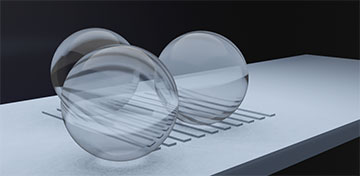
When placed on a specimen in an interference microscope setup, microspheres enable topographic measurements of structures below the physical resolution limit. [Image: L. Hüser et al., doi: 10.1117/1.JOM.2.4.044501]
For roughly a decade, scientists have known that placing tiny spheres or cylinders on top of a microscopy subject can improve the resolution of images beyond the diffraction limit. But the underlying physical mechanism remained unclear. Explanations of the spheres’ resolution-boosting magic have ranged from effective enhancement of the numerical aperture (NA), to the collection of evanescent waves or the action of whispering-gallery modes, to the formation of so-called photonic nanojets.
Now researchers based in Germany offer experimental results to help explain the theoretical underpinnings of this boost in resolution, using a technique that measures the topography of tiny objects below the diffraction limit without the need for fluorescent probe labels. (J. Opt. Microsystems, doi: 10.1117/1.JOM.2.4.044501).
Interferometric measurements
The team from the University of Kassel set up a Linnik interferometer to record a 3D-image stack of a 3D specimen under LED illumination at 440 nm. A Linnik interferometer is a two-beam instrument similar to the classic Michelson interferometer, except for the presence of measurement optics in both arms of the device. In this case, the scientists used magneto-optical lenses providing 100× magnification with an NA of 0.9.
During the experiments, the researchers placed one of several silicon dioxide spheres with a diameter of 7 to 10 μm on top of a standardized 3D rectangular grating and created the image stack with a CMOS camera moving in roughly 20-nm steps. Some of the trials involved microspheres of different materials and sizes, but the team concluded that spheres with more than 20 μm in diameter and a higher refractive index than silicon dioxide produced poor image quality.
Mathematical analysis
Next, the Kassel group analyzed their experiments in the spatial frequency domain and compared the results with ray-tracing computations that simulate the interaction of light with the microsphere. A more rigorous mathematical model based on near-field finite element method (FEM) calculations explored the phenomenon of photonic nanojets—narrow, high-intensity reflections from the back side of a sphere illuminated from the front (see “Photonic Nanojets,” OPN, January 2021). The FEM model “reproduces the major effects occurring in measurement results,” the team reported.
Ultimately, the presence of the microspheres enhanced the resolution of the NA-0.9 microscope by 11 %, the researchers observed. They also concluded, from their modeling, that the effective enlargement of the NA is likely the biggest contributor to the resolution boost provided by the spheres. The study “contributes to a deeper understanding of the underlying physical mechanisms,” said lead author Lucie Hüser, a doctoral candidate at Kassel, in a press release.
